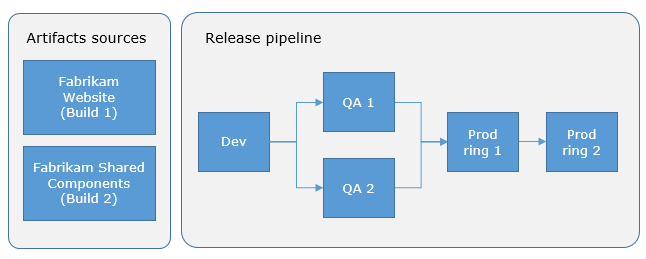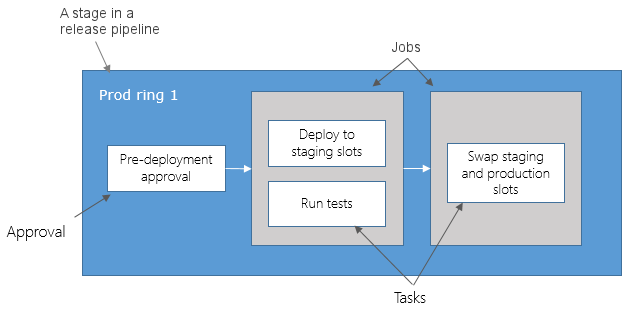Release pipelines in Azure Pipelines help your team continuously deliver software to your customers at a faster pace and with lower risk....
Release pipelines in Azure Pipelines help your team continuously deliver software to your customers at a faster pace and with lower risk. You can fully automate the testing and delivery of your software in multiple stages all the way to production. Or, set up semi-automated processes with approvals and on-demand deployments.

How do release pipelines work?
Release pipelines store the data for your pipelines, stages, tasks, releases, and deployments in Azure Pipelines.

Azure Pipelines runs the following steps as part of every deployment:
Pre-deployment approval: When a new deployment request is triggered, Azure Pipelines checks whether a pre-deployment approval is required before deploying a release to a stage. If it's required, it sends out email notifications to the appropriate approvers.
Queue deployment job: Azure Pipelines schedules the deployment job on an available automation agent. An agent is a piece of software that can run tasks in the deployment.
Agent selection: An automation agent picks up the job. The agents for release pipelines are exactly the same as the agents that run your builds in Azure Pipelines. A release pipeline can contain settings to select an appropriate agent at runtime.
Download artifacts: The agent downloads all the artifacts specified in that release, provided you haven't opted to skip the download. The agent currently understands two types of artifacts: Azure Pipelines artifacts and Jenkins artifacts.
Run the deployment tasks: The agent then runs all the tasks in the deployment job to deploy the app to the target servers for a stage.
Generate progress logs: The agent creates detailed logs for each step while running the deployment, and pushes these logs back to Azure Pipelines.
Post-deployment approval: When deployment to a stage is complete, Azure Pipelines checks if there's a post-deployment approval required for that stage. If no approval is required, or upon completion of a required approval, it proceeds to trigger deployment to the next stage.
How do I use a release pipeline?
You start using Azure Pipelines releases by authoring a release pipeline for your application. To author a release pipeline, you must specify the artifacts that make up the application and the release pipeline.
An artifact is a deployable component of your application. It's typically produced through a Continuous Integration or a build pipeline. Azure Pipelines releases can deploy artifacts produced by a wide range of artifact sources. such as Azure Pipelines build, Jenkins, or Team City.
Define the release pipeline using stages and restrict deployments into or out of a stage using approvals. Define the automation in each stage using jobs and tasks. Use variables to generalize your automation and triggers to control when the deployments should be kicked off automatically.
See the following example of a release pipeline that can be modeled through a release pipeline:

In this example, a release of a website is created by collecting specific versions of two builds (artifacts), each from a different build pipeline. The release is first deployed to a Dev stage and then forked to two QA stages in parallel. If the deployment succeeds in both the QA stages, the release is deployed to Production ring 1 and then to Production ring 2. Each production ring represents multiple instances of the same website deployed at various locations around the world.
See the following example of how deployment automation can be modeled within a stage:

In this example, a job is used to deploy the app to websites across the world in parallel within production ring 1. After all those deployments are successful, a second job is used to switch traffic from the previous version to the newer version.




COMMENTS